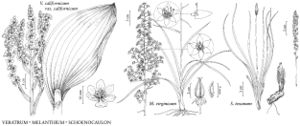Melanthium
Sp. Pl. 1: 339. 1753.
Gen. Pl. ed. 5, 157. 1754.
| Taxon | Illustrator ⠉ | |
|---|---|---|
 | Veratrum californicum var. californicum Melanthium virginicum Schoenocaulon texanum | Yevonn Wilson-Ramsey Yevonn Wilson-Ramsey Yevonn Wilson-Ramsey |
Herbs, perennial, subscapose, from erect, tunicate bulbs with short, vertical rhizomes; fibrils persistent, brown, stiff; roots contractile, fleshy. Stems erect, simple, leafy, hollow, basally thickened. Leaves basal, simple, reduced upwards, bases sheathing; blade linear, oblanceolate, elliptic to obovate, rarely plicate, glabrous, basally canaliculate, apex tapered to acute; sheaths tubular, closed. Inflorescences terminal, compound-racemose to open-paniculate, flexible, axes floccose; bracts clasping, linear to subulate. Flowers of distal racemes bisexual, progressively smaller distally, proximal flowers staminate; tepals persistent, 6, spreading, distinct to weakly connate basally, slightly adnate to ovary base, petaloid, gradually to abruptly narrowed into claws or claws absent, subequal, margin entire or undulate, apex acute to obtuse; perigonal nectaries obscure to very prominent, 2 per tepal, adaxially basal on either side of midvein; stamens 6, adnate to tepal bases; filaments strongly incurving; anthers basifixed, 1-locular, cordate-reniform; pollen-sacs fugacious, confluent, dehiscence apical/valvate; ovary superior to partly inferior, nearly distinct, 3-locular; sepal nectaries absent; styles persistent, 3, spreading to recurved, turning inwards with age, distinct; stigmas minute; pedicel pubescent. Fruits capsular, deeply 3-lobed, dehiscence septicidal, then adaxially loculicidal; styles persistent, 3, beaklike. Seeds pale-yellow to tan, broadly winged, flat, elliptic to lanceolate. x = 8.
Distribution
e North America
Discussion
Species 4 (4 in the flora).
Melanthium, often wholly or partly included in the closely related Veratrum (J. D. Ambrose 1975, 1980; S. M. Kupchan et al. 1961; J. H. Zimmerman 1958; W. B. Zomlefer 1997b; W. B. Zomlefer et al. 2001), is treated here as distinct (N. L. Bodkin 1978; B. Mathew 1989; M. N. Tamura 1998; S. Fuse and M. N. Tamura 2000). The eastern North American species of Melanthium differ from Veratrum primarily in their open inflorescences, which appear delicate and flexible; glabrous leaves; clawed tepals with two distinct, nonmarginal glands on either side of the midrib; and incurving, fugacious stamens adnate to the tepals (N. L. Bodkin 1978).
Resolution of the problematical Melanthium–Veratrum species series will require full molecular and phylogenetic analysis of the group, especially of the narrow-leaved Asian Veratrum, several of which approximate Melanthium, such as V. mengtzeanum Loesener, V. micranthum Wang & Tang, V. stenophyllum Diels, and V. taliense Loesener f. (B. Mathew 1989).
In eastern North America, an ecological replacement gradient occurs within the genus. Melanthium virginicum occurs mostly in wet habitats at lower elevations, while the Appalachian M. latifolium and the Ozark M. woodii commonly grow on mesic slopes, and M. parviflorum is most frequently found on or near mountain crests.
Species of Melanthium should be considered poisonous, since complex alkaloids derived from steroidal precursors, similar to those in Veratrum, are present (S. M. Kupchan et al. 1961; R. Hegnauer 1962+, vol. 2; R. M. T. Dahlgren et al. 1985).
Selected References
None.
Key
| 1 | Leaves linear to narrowly oblanceolate; tepal bases clawed or abruptly attenuate. | > 2 |
| 1 | Leaves broadly oblanceolate to obovate; tepal bases very gradually attenuate. | > 3 |
| 2 | Tepals ovate to obovate-oblong, apex acute, margins entire, abruptly auriculate to hastate basally; stamens inserted at or above middle of claw. | Melanthium virginicum |
| 2 | Tepals orbiculate to rhombic, apex shortly acuminate, margins strongly undulate, abruptly attenuate basally; stamens inserted at or below middle of claw. | Melanthium latifolium |
| 3 | Tepals rhombic-oblanceolate, greenish yellow to olive green; tepal glands obscure; ovary glabrous; filament bases barely 1/3 as wide as tepals at insertion point. | Melanthium parviflorum |
| 3 | Tepals obovate-oblanceolate, purplish maroon to chocolate brown; tepal glands dark purple to black, obcuneate; ovary finely tomentose; filament bases 1/2 or more as wide as tepals at insertion point. | Melanthium woodii |
"broad" is not a number."thicker" is not a number.